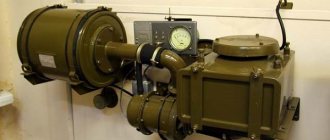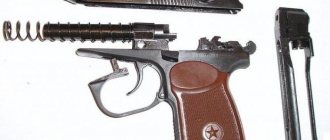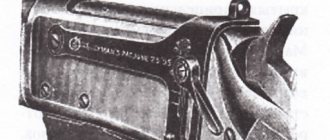Soldiers fire from AK-12 and AK-15 assault rifles. Modern armies and law enforcement agencies use many different types of firearms. Some of them are highly specialized, others can be used to solve several problems. The most universal weapon, suitable in almost all cases, remains machine guns. They arose relatively recently, but developed very quickly. Today, the predominance of assault rifles over all other types of rifles looks self-evident and natural, but this was not always the case. The new weapon made its way for quite a long time, and only in the USSR was it immediately appreciated.
Purpose of devices
The main function assigned to circuit breakers is to protect the cable from short circuits and overload. In addition, the set of tasks for the device includes:
- transmission of rated load current during long-term use;
- stable maintenance of the network voltage potential with a guarantee of its insulation;
- the ability to manually control the state of the power contact;
- the ability to determine when an overload occurs and provide the necessary time for safe operation, after which power is removed from the connected consumers.
It is important to choose the right type of electrical circuit breaker, taking into account the technical characteristics of the network, since frequent power outages can have disastrous consequences for the connected devices.
To do this, it is worth understanding how a circuit breaker works. A device designed for high power is not always appropriate, since a dangerous situation in a domestic area may not be recognized. Current strength that goes beyond the permissible norm for the cable is often not detected by the circuit breaker as an emergency position. Then a short circuit can be caused by melting of the insulation, but by this time there is a risk of fire. A circuit breaker device with a lower power can often and regularly stop the supply of voltage to the consumer. As a result, the machine will stop functioning due to contact failure.
General characteristics
An automatic electrical switch is a switching device that passes through its structure a current of rated strength. When necessary, it turns off the circuit, for example, during a short circuit or when power consumption increases. Currently, there is a single-phase, two-phase and three-phase device, answering the question of what types of electrical machines there are. They differ from each other in the number of elements that disconnect the current.
What does it look like
The device is designed to protect the electrical circuit so that overloads and short-circuit currents do not occur. It can be reused many times. It always works reliably.
Note! The main parameter of an electric machine is the number of rated current transmissions, the current energy that is needed for household electrical appliances to work normally. In a private house and city apartment, a 6-63 ampere machine is installed. Experts recommend dividing the electrical network at home into a pair of circuits and installing each circuit on its own switch.
Protection of electrical equipment from overcurrent as the main purpose
Varieties by poles
Automatic machines can have from 1 to 4 poles, which is determined by the power of the connected electrical equipment and the number of network phases.
Classification according to the number of poles of circuit breakers:
- A single-pole circuit breaker is capable of protecting the network to which low-power devices are connected. Installation is carried out on the phase wire, the neutral wire is excluded.
- A two-pole device is relevant for a line to which fairly powerful household appliances are connected (washing machine, electric stove, boiler).
- Three-pole model. Intended for semi-industrial scale with connection of installations: pumps, devices for auto repair shops or construction work.
- The four-pole circuit breaker protects against short circuits and overloads of four-wire networks.
For a four-core cable, only three- and four-pole circuit breakers are installed.
Second place - M4 (USA)
Our main competitor is located here. The automatic carbine began production in 1994, replacing the popular M-16. It differs from its comrades in that it can be equipped with a large number of different additional equipment .
- Sighting range - 500 meters
- Rate of fire - 900 rounds per minute
- Weight - 3.4 kilograms
- Magazine capacity - 40 rounds
- Initial bullet speed - 936 meters per second
M4
Including the United States, the assault rifle is used by the armed forces of 40 countries . Among them are Bahrain, El Salvador, Iraq, Jordan, New Zealand, Chile.
The M4A1 carbine performed well in combat during the wars in Afghanistan and Iraq, gaining a positive rating among American military personnel.
Classification by time-current indicator
The number of false alarms of automatic circuit breakers under uneven load on the network is optimized due to different speeds of response to exceeding the rated current. The dependence of the network shutdown time on the strength of the flowing current determines the following types of circuit breakers:
- A. Available from European manufacturers. The most sensitive model. It responds instantly to deviations from the norm. Typically used to protect lines with connected high-precision equipment. (Current rating 2-3). Rarely installed.
- B. Designed for rooms equipped with old aluminum wiring. Suitable for long lines, lighting lines or circuits without possible sudden voltage changes. It turns off with a slight delay of 5-20 seconds at a current rating of 3-5.
- C. More often found in modern apartments to protect outlet lines into which a sufficient amount of electrical equipment is connected (washing machines, dishwashers, freezers, heaters, microwave ovens, LCD TVs). Shutdown occurs in 1-10 seconds at a current multiple of 5-10. This principle is needed to stabilize operation with a slight difference.
- D. Protection is optimal for lines with transformers or high inrush currents. Circuit breakers of this class cannot be connected to consumers oriented to work with protection classes C and B. At 10-20 rated current it turns off in 1-10 seconds. Lowest sensitivity to increased current. Sometimes it is customary to install it on the building itself in order to secure apartment automatic machines. If they suddenly do not work, the entire building will be disconnected from the network.
These are the most common types. The range of production models has been supplemented by three more groups: L, K and Z.
How to choose
You need to select a device based on the number of rated current, poles, response time characteristics and breaking capacity. Also, of course, you need to look at the brand, labeling and price of the device.
Note! When choosing, it is worth starting from the total amount of power of electrical equipment.
Determining the power of the machine
You can determine how much equipment power is needed by summing up all the real power of each individual electrical device included in one network. This can also be identified through the table below. The data is average according to regulatory documents.
It is important to understand that more electricity and the corresponding greater power of the unit may be needed, since additional devices may be purchased that were not previously taken into account.
Power table of household appliances and tools
Calculation of the rated power of the machine
You can calculate the rated power or the power at which the wiring will not turn off using the formula M = N * CT * cos(φ), where M is the power in watts; N - voltage of the electrical network in volts; ST - current energy that can appear in the device; cos(φ) - the cosine value of the phase angle with voltage.
Rated current calculation
You can find out the current rating by looking at the electrical wiring documentation. To calculate without it, you need to know the conductor cross-sectional area and the method of laying it.
Note! Next, the values must be substituted into the formula S = 0.785 * D * D, where D is the conductor diameter; S—conductor cross-sectional area.
Conductor cross-section table
Determination of time-current characteristic
To correctly calculate the current characteristic over time, it is necessary to read the starting currents. To find out everything, you should use the following table below.
You might be interested in: Definition and connection of SPDs
Starting current table
Classification by design
There are three types of network protection circuit breakers:
- Modular device. Relevant for household networks with small currents flowing. Most often it has one or two poles.
- Cast. Used to work in industrial networks. The name was given due to the cast body.
- Air electric. Suitable for networks supporting high-power installations. Usually has three or four poles.
AS "Val"
The weapon was created by Soviet engineers in the 1980s and is still used by various special forces of the Ministry of Internal Affairs and the FSB. One of the most important advantages of a shotgun is its noiselessness. It can be easily disassembled and stored in cases or small wallets. AS Val is also included in the ranking of the best assault rifles in the world due to the ability to use different types of cartridges. You can install a night vision device. The machine's own weight is only 2.5 kg. The main disadvantages are the short aiming range, which is only 400 m, as well as the box magazine with a capacity of 20 rounds. The weapon was actively used during two Chechen wars.
INTERESTING TOP 10 Most popular social networks. networks
Separation according to rated breaking capacity
According to the criteria that determine the value of the short circuit current at which the circuit breaker will trip and subsequently cut off the voltage supplied to the consumer, three types are distinguished:
- 4.5 kA (4500 A). Most often used to protect power lines of private residential buildings with a resistance of 0.05 Ohm. Such models are practically not used; some countries have already banned their use.
- 6 kA (6000 A). Used to prevent short circuits in public places and residential areas where the resistance is approximately 0.04 ohms.
- 10 kA (10000 A). The machines are designed to protect electrical equipment for industrial use.
For domestic purposes, 6000 A is most often used.
Legrand series of circuit breakers: collection overview
The Legrand company offers machines for household and technical use. Their distinctive features are reliable materials, new technologies, and complete safety. The online store website presents more than 480 circuit breakers. To choose the right model, you can use a convenient filter system. It is most convenient to focus on the series produced:
RX3.
It belongs to the budget segment, the breaking capacity is 4500 A. Simple installation, reliable design, safe operation and affordable price make this line very popular. According to its characteristics, the device is suitable for use in apartments, residential buildings, small offices or retail spaces. The series received insulated tunnel-type clamps marked IP2X. The cross-section of the connected conductors is up to 35 mm². Both Phillips and flathead screwdrivers are suitable for servicing. For DIN rail mounting, latches with two locking positions are provided on the rear of the device. The body is made of durable plastic. The manufacturer claims increased wear resistance of the machines - up to 10,000 electrical and 20,000 mechanical operations. the operating temperature range is expanded from -25 to +75°C. The build quality is confirmed by international and Russian certificates.
TX3.
A line of circuit breakers with a breaking capacity of 6000 A or 10000 A, class B or C, with a rated current from 6 to 63 A. The releases are thermomagnetic. Inside the body made of self-extinguishing polyester there is a cavity for air circulation, which prevents the device from overheating. The degree of protection of the shell is IP40, the clamps are IP2X. The terminal terminals are equipped with sealable covers. They are used for installation in distribution boards at industrial and commercial sites. Type B machine guns are recommended to be installed to protect wooden houses and cottages.
DX3.
Powerful devices for use in large residential complexes and commercial facilities where a high degree of reliability and safety is required. Breaking capacity up to 50 kA, rated current – up to 125 A. Rated voltage – 230/400V, 400V. Legrand cares not only about people, but also about nature - 80% of the raw materials used are recyclable. An additional plus is a plastic window for manual marking, color designation of the toggle switch positions (red - on, green - off). Within one line, you can select a machine for the needs of a general or separate branch, which ensures selectivity of the circuit.
The Legrand catalog contains all of the above series. These are one-, two-, three- and four-pole devices of class B or C
. Traditionally, the number of modules corresponds to the polarity of the device. All products are marked and have accompanying documentation (certificates). To facilitate search and selection, a system of filters by characteristics and sorting by popularity, price or article has been developed.
Types of releases
The protection includes an electromagnetic and thermal release. The operation of each element is autonomous and does not depend on the state of each other.
The thermal release is a metal plate whose purpose is to respond to heat. To turn on the device, the plate must cool to the initial permissible temperature.
The operating principle of the circuit breaker depends on the specific situation.
Work mode
Electric machines are activated by raising the control lever. The charging and releasing mechanism switches to the active state. Switching of power contacts occurs: current flows between them (from stationary to moving). After this, the movement continues through the flexible connection to the coil of the electromagnetic release, and then through the flexible connection to the thermal release. The current enters the “supply” power line through the bottom terminal.
Mechanism of action during short circuit (SC)
Timely shutdown of the load supply is ensured by an electromagnetic release. The principle of operation of a circuit breaker during a short circuit boils down to the following scheme: a voltage exceeding the permissible norm, flowing through the electromagnetic coil of the release, forms a high-power magnetic field. As a result, the armature with the moving contact moves down, acting on the trigger lever, after which the load is turned off.
Thus, the immediately arising magnetic field provokes a reaction to de-energize the network before an emergency occurs.
During the occurrence of a discharge, combustion products are formed between the contacts, and the pressure inside the machine body also increases. It is necessary to eliminate side reactions, for which channels are provided in the machine box.
Overload
The network is protected thanks to a thermal release - a bimetallic plate. In this case, the current flowing through it may exceed the normal value, which leads to its overheating and subsequent bending. Reaching a certain bending angle, the plate acts on the trigger device, during which the machine turns off.
Heating up the bimetal takes time. The duration depends on the degree of excess of the applied current and can be several seconds or last up to an hour. This property allows you not to turn off the power in the event of short-term or accidental excess current in the network. The lower limit of the permissible value at which the thermal release is triggered is set by the manufacturer. The correct operation of the thermal element can be influenced by the ambient air temperature. The technical parameters indicated in the marking are relevant for temperatures up to 30 degrees. In a cool room, the current can reach a value higher than the permissible value; in a hot room, it can trigger at a lower value.
The thermal release is slower than the magnetic release, but has the advantage of being more accurate and easier to set up.
AN-94 "Abakan"
In second place is the AN-94 Abakan, created in the 1980s with the intention of at least partially eclipsing the AK. The designers were tasked with making it more powerful, with increased accuracy of fire and just as reliable.
The peculiarity of the Abakan is that when firing, the barrel moves back, reducing recoil. In two-round or long burst mode, the first couple of shots are fired at a rate of 1800 per minute. Subsequent ones - 600 per minute.
However, Abakan was not destined to displace AK. They released it in batches too small for the army.
Marking
All circuit breakers, regardless of the manufacturer and their type, are marked according to a single scheme, including the main parameters:
- manufacturer's name or logo;
- type indication, according to the manufacturer's series number and catalogue;
- operating voltage value: designation of alternating current is a wavy line, direct current is a straight line, combined is two lines at once;
- the value of the operating current (indicated without the measurement value in amperes), the type of time-current characteristic is indicated before the current value;
- operating frequency (in the case when only the set frequency is used);
- short circuit switching capacity (in Amperes);
- the degree of protection is indicated in the form of IP;
- The current limit class is indicated in a rectangle (value from 1 to 3);
- designation of the terminals: for connection to the neutral conductor - N, for connecting the protective line - grounding symbol.
The lever itself contains a status designation: “off”, “on” or “1”, “0”. While turning off occurs automatically, turning on can only be done manually.
A circuit breaker reduces the risks caused by short circuits or sudden blackouts to a minimum.
Fourth place - FN SCAR (Belgium)
Combat assault rifle for special operations forces, released in 2003. It is the most effective assault rifle among similar models.
- Sighting range - 900 meters
- Rate of fire - 625 rounds per minute
- Weight - 3.1 kilograms
- Magazine capacity - 30 rounds
- Initial bullet speed - 870 meters per second
FN SCAR 17S
In addition to Belgium, the rifle is in service with 24 countries , such as Italy, Serbia, Bhutan, Kenya, USA, Bosnia and Herzegovina, England.
was declared the best in 2004 . Since then, the FN SCAR carbine has been equipped with the American Rangers (a special-purpose parachute reconnaissance regiment of the US Army).











